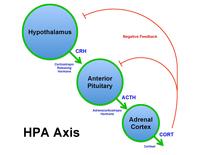
Photo from wikipedia
The hippocampal CA2 region has received greater attention in recent years due to its fundamental role in social memory and hippocampus‐dependent memory processing. Unlike entorhinal cortical inputs, the Schaffer collateral… Click to show full abstract
The hippocampal CA2 region has received greater attention in recent years due to its fundamental role in social memory and hippocampus‐dependent memory processing. Unlike entorhinal cortical inputs, the Schaffer collateral inputs to CA2 do not support activity‐dependent long‐term potentiation (LTP), which serves as the basis for long‐term memories. This LTP‐resistant zone also expresses genes that restrict plasticity. With the aim of exploring social interaction and sociability in rats that were subjected to juvenile stress, we addressed questions about how the neural circuitry is altered and its effects on social behavior. Although there was induction of LTP in both Schaffer collateral and entorhinal cortical pathways in juvenile‐stressed rats, LTP declined in both pathways after 2–3 h. Moreover, exogenous bath application of substance P, a neuropeptide that resulted in slow onset long‐lasting potentiation in control animals while it failed to induce LTP in juvenile‐stressed rats. Our study reveals that juvenile‐stressed rats show behavioral and cellular abnormalities with a long‐lasting impact in adulthood.
Journal Title: Hippocampus
Year Published: 2023
Link to full text (if available)
Share on Social Media: Sign Up to like & get
recommendations!